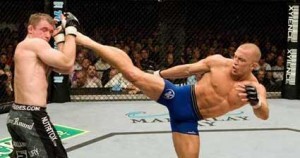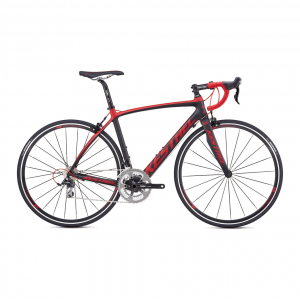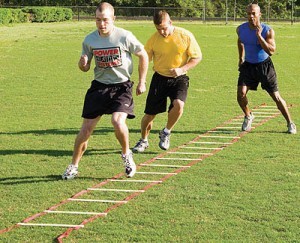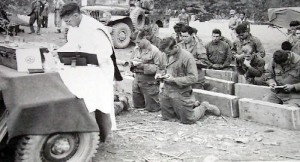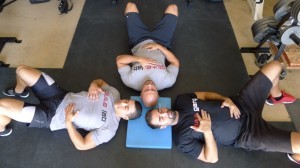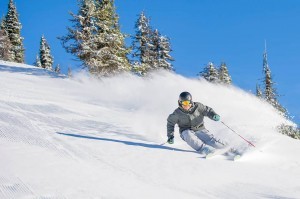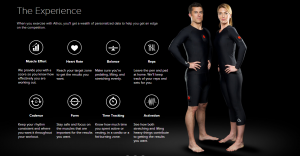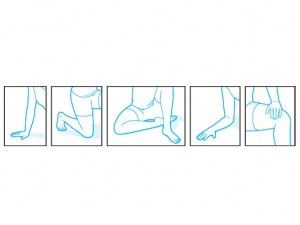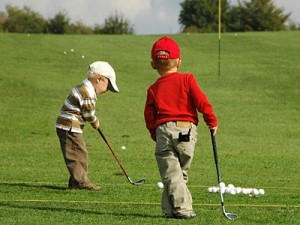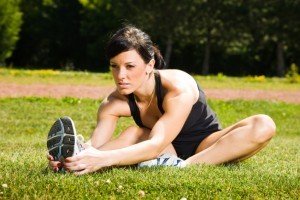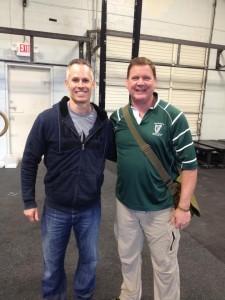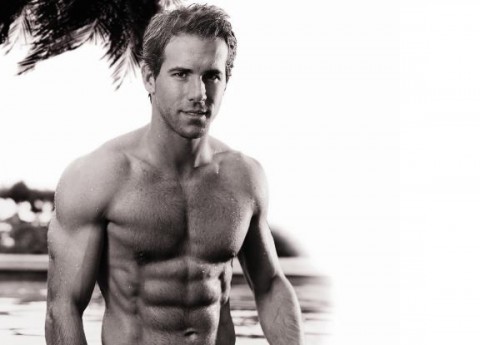Are you a golfer? If you live in Kelowna there's a good chance you are because the sport is huge here and people can play 6 or 7 months of the year with over a hundred courses to choose from. But even if you're not from the Okanagan you may an interest in getting in a round every now and again. And the funny thing about golf is that it's so hard to master. It's pretty tough to have your driver dialed in, hit your irons tight to the pin and then drain all the short to medium distance putts. What's even funnier is the emphasis we place on driving compared to putting when it comes to practice. People will hit hundreds of drives at the range but zero putts. And during a round they may pull the driver out of the bag 18 times max during a round but putt anywhere from 1-3 times per hole. So 18 total drives versus 18-54 putts per round. And with a few par 3s thrown in there there's no way you will use the driver 18 times. Anyways, you get it. To lower your score work on your putting. So how can you shave strokes off your score with improved putting? Well I'm not a golf pro so won't tell you anything about grip, club path or how to read a green. Instead I want to give you 2 tips from training that should help you make more putts. Tip #1 - Set the Stone, Fire the Hammer[caption id="attachment_4294" align="aligncenter" width="300"] GSP sets the stone and drops the hammer on Hughes' head. A few years ago I was able to set Dr. Stu McGill present in California. And if you're familiar with Dr. McGill he's one of the premier spinal researchers in the world....
Stretches & Exercises for Cyclists
- Chris Collins
- Fitness
- Training
- Injury Prevention
- 1495 Hits
- 0 Comments
-
Do you like to cycle? If you live in Kelowna there's a good chance you own a bike and are familiar with the various gran fondos and triathlons that take place in the Okanagan. Recently I sold my car and needing something else to commute I thought I'd pick up a road in the meantime. I went for a road bike over a mountain bike for a few reasons. One was that we live on a hill and going home at the end of the day is a lot easier on a 16 pound versus a 40 pound bike. Plus the speed of road cycling is definitely appealing. [caption id="attachment_4300" align="aligncenter" width="300"] My new ride. A 2014 Kestrel Legend. So I picked up a Kestrel Legend and love it! Whenever I plan morning rides with friends I tend to wake up in the middle of the night and start getting dressed thinking it's time to go. Nevermind the fact it can been anywhere from 1230-330 am and pitch black outside. I'm ready to go riding. But as I ease into to this sport I am noticing a few things I will need to tweak with my training. And if you're into riding as well these may help you also. 1. Stretch my hipsWhen you're riding your hips are flexed. Other than the fact your knee and ankle are moving the hips are in a fairly constant position of flexion. So to balance this out will mean extra timing with the lacrosse ball, foam roller and hip stretching in general. [caption id="attachment_4301" align="aligncenter" width="248"] Rear foot elevated hip flexor stretch. Ensure the knee-hip-shoulder-ear all line up. While on a ride I will stand on pedal and drive my hips forward to the handle bars as much as possible. I'll hold that position for as...
An Easy Way to Be Better at Every Sport
- Chris Collins
- Fitness
- Training
- 1532 Hits
- 1 Comment
-
Do you remember growing up and having your parents drill into you proper manners? I'm talking specifically ones that had to do with your mouth. You know what I mean? [caption id="attachment_4312" align="aligncenter" width="300"] Poor manners cost him a lucrative pro career. 'Chew your food with your mouth closed' 'Don't smack your gum' 'Close your mouth' And besides helping me develop proper manners and etiquette so I won't be a social outcast this also helped me with my sports performance. So thanks mom & dad! But how exactly does chewing with your mouth closed help with sports performance? Well honestly it has nothing to do with the nutrition and more to do with how we take in oxygen and expire carbon dioxide. I've got to give credit to Mr. Sherwin, my high school science teacher, for teaching me some of the following. Below are 4 benefits of nose versus mouth breathing. Benefit #1 - Nasal air is warmed and humidifiedWhen you consider the location and properties of our lungs we know they are in the chest cavity and moist to facilitate inflation, deflation and gas exchange. The more similar the air we breath in is to this environment the better. For example, air taken in through the mouth needs to warmed and moistened before arriving at the lungs. ***I remember when going to university in Regina riding my bike in the middle of winter. In -35 C weather I learned that although you may be tempted to ride quickly to get out of the cold weather more quickly this caused me to breath through my mouth and typically was followed by a sore throat or chest cold. It was a better strategy to bike more slowly and keep my mouth closed. This allowed me take air in through my nose only and...
How to Get Started with a Heart Rate Monitor
- Chris Collins
- Fitness
- Training
- Fitness Equipment
- 1560 Hits
- 1 Comment
-
Many people are into running, cycling, triathlon and other endurance events. It's surprising with how much is invested into these sports both in terms of time and money that more people don't use heart rate monitors.Why is using a heart monitor such a great idea? Well it for starters it allows the user to get better results in less time. It makes training more efficient and safer.[caption id="attachment_4325" align="aligncenter" width="300"] How far would you drive without any feedback?Consider owning a high performance sports car such as a Ferrari. You only drive this car in the summer and only on certain roads. It never sees the rain or snow. If you have to park you are that jerk that takes up two spots to give a large buffer. Servicing is done by the only person within 100 miles that works exclusively on Ferraris. It only takes premium fuel and you make sure to log and note everything about this awesome machine.Now let's say you plan to take your Ferrari out onto the highway for a few hours to have some fun. You want to test out the handling, the acceleration, how it climbs and most importantly to feel the top end speed.Only one problem...none of your gauges are working. While you can start and turn the car on all of the needles for every gauge are buried to the left. So you can't read the speed, temperature, tachometer...nothing works.Are you still going out for that drive with no feedback on how the car is performing? Probably not. I'm guessing some people might even call for a flat bed tow truck as to not risk doing any damage to the vehicle while out on the drive.But guess what? You are way more valuable and rare than a Ferrari. In a lifetime you could own...
4 Tips for Speed
- Chris Collins
- Fitness
- Training
- 1627 Hits
- 1 Comment
-
If there was one quality I would always choose as a coach it would be speed. You can have big players and strong players. You can have fit players and smart players. But the truth is that speed kills. Period. So knowing the importance of speed how do we get faster? Unfortunately many still believe this is the way to develop speed. And while 'speed' ladders might be useful for working on different footwork patterns, coordination or simply to help an athlete warm-up they don't do much in terms of speed development. Below are four ways to improve your speed and dominate your game. Speed Tip #1 - Increase Your Stride RateThere is formula that gets passed around coaching circles that speed = stride rate x stride length. While there is some truth to this there is more than be done than simply working on these two qualities. When we talk about stride rate we are referring the the turnover of the legs. How quickly can an athlete take a given number of steps when sprinting. And primarily what we are concerned with here is training the relevant muscles to fire quickly. And to do so is not so much a questions of strength or fitness as it of nervous system development. There have to be elements in the training program where the athlete is performing movements at high speed with sub-maximal loads. Speed Tip #2 - Increase Your Stride LengthHave you ever seen an athlete whose arms and legs are moving really fast? But the weird thing is they aren't moving faster than any of the other athletes in the game. Some coaches get fooled into thinking some of their athletes that move like this are really fast. But when you test them they aren't fast. And in games they...
Reflections on my lactate testing
- Chris Collins
- Fitness
- Training
- 1621 Hits
- 0 Comments
-
If you are serious about getting better at something than you need to test yourself every now and again. For example, you can't claim to be a fast runner if all you do is go for runs but have never stepped up to the line in a race to measure yourself. However that's the way a lot of people approach their training. The put in training session after training session, week after week and this continues on indefinitely. Not only does this approach never really tell you how good you are if never really tells you what your weak links are and what could be improved. Lactate Testing at UBCORecently I had the opportunity to go out to UBCO and do some testing. This was a test performed on a stationary bike to determine my VO2max, lactate threshold, max power and other interesting facts about what my body does when cycling. The first thing you notice when you do this test for the first time is that it's not comfortable. And I'm not talking about the physical discomfort. That comes later. Instead I'm talking about the unusual sensation of having your nose plugged and a snorkel type of mouth guard connected to tubing that can measure your expired air. In other words a computer can detect changes in the amount of oxygen and carbon dioxide in the air that is exhaled. So picture a halo type of apparatus sitting on top of your head, with a mouth guard and tubing attached to the computer beside you and a nose plug to ensure gas exchange only occurs through the mouth. And this is what is a little uncomfortable. Because once in a while in normal living we may have to take an irregular breath. Instead of the normal inhale-pause-exhale pattern of breathing sometimes we...
Why Use a Heart Rate Monitor
Do you use a heart rate monitor when you train? I guess at most big box gyms the majority of people don't. I mean when you consider that most people don't have a training journal to record their workouts they probably aren't going to go to the trouble and expense of investing in a heart rate monitor. But for those that do have and use a heart rate monitor I'm curious as to what they monitor? Again if I had to guess what number most people check first when they complete a training session I would say it's the calories consumed. And this is kind of amusing because: A. This is simply a rough estimation of correlating calories burned with elevated heart rate. If this is all it took to get lean we could probably just watch marathon horror movies every day to spike our heart rates repeatedly, burn tons of calories, and get lean. B. The estimation is just that. It uses an average and includes the calories burned while at rest. In other words if my body uses 50 calories at rest and 110 calories to go for a hike than the hike only burned 60 calories. But the display on my heart rate monitor would show 110 calories and perhaps give me a false impression of how effective a particular training session was. But other than tracking the calories consumed a heart rate monitor can tell us the duration of our exercise, our average heart rate and our maximal heart rate. Now you can always pick up models with other functions that include lap functions, GPS, elevation and other things but at minimum you'll get heart rate data. So why would I want a heart rate monitor anyway? Can't I simply stop and check my pulse every now-and-again? To answer...
How to Improve Lactate Threshold
- Chris Collins
- Fitness
- Training
- 1639 Hits
- 0 Comments
-
In the last post we talked about why people may use a heart rate monitor. Click here if you missed that post. Besides the most common value people check when they use a heart rate monitor, which is calories burned there are a number of other benefits to using one. But first we should do a quick review so we're all on the same page as to what we're talking about. So here's a quick recap of some of the terms you may get thrown around on blogs and in training circles. Anaerobic Threshold - This is the intensity of exercise where energy demands cannot solely be supplied by oxygen and must be supplemented by anaerobic metabolism. Lactate Threshold - As the demands for energy produced anaerobically increase there is a lactate accumulation in the blood as well. Lactate accumulates because it is being produced faster than it can be cleared from the blood. The units for this measure may be expressed as mmol/L. VO2max - This is the highest rate of oxygen consumption at maximal intensity exercise. In other words when we are below our VO2max we can still consume more oxygen with increasing intensity. However once our VO2max has been achieved further increases with intensity will not result in increased oxygen consumption. In terms of units it is usually expressed as ml/kg/min. If I've worked with you before or you are familiar with our coaching style at Okanagan Peak Performance Inc you'll know we use a lot of analogies. So here's the analogy for lactate threshold and VO2max. Lactate Threshold is like the floor in your home. VO2max is like the ceiling. With my own training I would like to improve my lactate threshold. In other words I want to raise the floor up towards the ceiling. Let's throw...
What to do about tight hamstrings
Ask 100 people that train where they are most tight and you will probably hear hamstrings singled out as one of the most common problem areas. I would include tight hips as well as the two are intimately related and if you have tight hamstrings more than likely have tight hips as well. So first of all, if this really a case of tight hamstrings? And, if so, what can you do about it? To answer the questions to these we need to go back the basics. This means evaluating a person's static posture. I like the way Dan John describes the relationship of the hips/pelvis and the rib cage. He says to imagine the hips/pelvis as a bowl of water with a box sitting on top. Does the bowl of water sit level? Or is there water leaking out of the front (anterior tilt) of the bowl? Or out of the back (posterior tilt)? Before we can even start to think of lengthening or shortening any of our tissues or structures we need to know that the foundation is solid. A quick and easy drill to learn the range of the hips and pelvis is the cat and camel. Starting on hands and knees imagine spilling water out of the front of the bowl. You should notice an increased arch through the low back. Next try and spill some water out of the back of the bowl. Dr. Jeff Cubos, who presented at the inaugural OSCC, used the analogy of trying to scoop ice cream with your butt. Use whichever analogy works for you. http://youtu.be/CXRsjICsGnc Once we have established a neutral hip and pelvic position we need to recognize that tight hamstrings may also be due to weak lower abs and/or hip flexors. Think about it this way. If you had...
Fitness Training in Cold Weather
- Chris Collins
- Fitness
- Training
- 1633 Hits
- 0 Comments
-
So the weather has dropped significantly here in Kelowna over the last week. And I'm sure the rest of Canada is calling us weak for complaining about the weather when we have some of the mildest weathers in the country. But if we didn't talk and occasionally complain about the weather we really wouldn't be Canadian, would we? And before we either settle in for a complete season of hibernation or rush straight to continue our outdoor training there are a few things to consider with outdoor training in the winter. 1. Lower Relative HumidityWhen the mercury drops the cold air can hold less water and relative humidity drops. There is then a greater likelihood that we will lose water from our cells as a result to this difference. As a result we have to make sure to drink enough water prior to training and to continue to hydrate during exercise. Typically we only think to hydrate in warmer temperatures and forget to do so during the winter. Be aware of the increased need as a result of changes in humidity. 2. Nasal BreathingI remember when I was going to grad school in Regina riding my bike to the lab in the winter. It would be -35 C out and your extremities would be so cold. It would take forever for my toes, ears and nose to thaw out. And even though it was painfully cold you could only ride so fast. The reason you couldn't just sprint was that the air was so cold you couldn't inhale through your mouth and warm the air enough. It would reach you lungs still cold and feel as though pneumonia was inevitable. When you venture out in cold temperatures make sure to control your breathing enough so that you can in inhale mostly through your...
What is the best cardio to do?
- Chris Collins
- Fitness
- Training
- 1584 Hits
- 0 Comments
-
People love 'best of' lists. Whether it be when buying a car and picking up a copy of Consumer Reports or watching David Letterman's Top 10 List we love to have things ranked for us.And a common question coaches and trainers get from their clients is 'what is the best...' and you can fill in the blank for whatever it is someone might ask when working with a fitness professional.For example, you might hear questions about what is the best stretch for this muscle group, or what is the best supplement I should take and another popular one is what is the best type of cardio I should be doing?Let's take a look at this last question, what is the best type of cardio I should be doing, and answer that one first.Step #1 - What is the Purpose?The first thing we need to know is why I are we choosing to do cardio in the first place? Is the end goal fitness or performance? Knowing the answer to this gives us a better idea of what the next step should be. Let me take a moment to explain.Actually, I'll back up another step here first as well. While the title and the body of this blog uses the term 'cardio' know that we mean energy system training (EST). When we say cardio, or cardiovascular, some people will understand this to mean aerobic training and not consider anaerobic types of training. However, fewer people will use the term energy system training, which includes aerobic and anaerobic training, so we are going with what most people are familiar with which is 'cardio'.Now to address the previous question are we looking to do some energy system training (EST) to get better for a sport or performance or are we looking it as a...
A Great Drill For Low Back Pain
Low back pain is something almost everybody experiences at some point in their life. And once we've suffered through some low back pain we usually want to know what caused the pain and what to do about ensuring it doesn't happen again. And while there may be a variety of causes and types of low back pain there are some things in common to all. First of all, in order to prevent future episodes of low back pain we want to to ensure we have a solid foundation and can move through an optimal range of motion. To look at the first condition for a solid foundation we need to consider our posture. Do the joints of the body stack evenly like pieces of lego? Or are there some areas where they are deviations from optimal alignment and smooth curves? This may get tricky for the lay person because how are they to know what is optimal? And often times manuals and references used technical terms which can confuse even people who work in the fitness industry. In this case I like the way Dan John describes the relationship of the hips and pelvis with the torso. He has described this as a box (torso) sitting on a bowl of water (hips & pelvis). Does the box sit squarely on the bowl of water? And is any water leaking out of the bowl of water? If so, is water leaking out of the front of the bowl (anterior tilt) or the back of the bowl (posterior tilt)? If the rib cage is flared or tilted up than the box is not sitting squarely on the bowl of water. And if we are spilling water than we know how to correct this problem as well. The solution comes via the kneeling plank. It...
How to Recover More Quickly
- Chris Collins
- Fitness
- Training
- Work-Out Recovery
- 1656 Hits
- 0 Comments
-
I've written before about the importance of breathing on this blog. But a recent session with a client caused me to think it may be worth revisiting. The session I am referring to was with a young client who was doing a vertical load of resistance exercises. This basically means he would do one exercise, move to a different second exercise and finish with a third exercise before taking a rest. This is different from horizontal loading, which is seen in many big box gyms, and involves doing a set of a particular exercise, resting for the prescribed amount of time, then repeating this to complete all the sets before moving on to the next part of the training session. Not only does vertical loading allow for greater workout density it also allows for greater intensity. You can train more intensely because you have more time from one lift until you repeat that same lift again. There are two other exercises plus a rest break before completing the next set of the same exercise. But this post isn't about program design. Instead it's to illustrate the importance of proper breathing during training. Now as you can imagine doing a workout of this type your heart rate will begin to climb. And if you are a little bit deconditioned, tired, under-fueled, dehydrated, stressed or coming down with a cold your heart may have to work a little harder than normal to do the task at hand. And as your heart rate climbs and you try to push yourself you may find you aren't recovering adequately to maintain the intensity and pace of your workout. Since safety precedes results you need an option here. Here's what we did for this client that helped him complete not only this set but the rest of...
5 Steps to Your Best Training Session
- Chris Collins
- Fitness
- Training
- Injury Prevention
- 1586 Hits
- 0 Comments
-
When you have a great training session what is about the session that made it great? Was it that you hit a PB on a lift? Was it the people you trained with that made it memorable? Was it how well you moved and how the exercise felt? Personally I know many of my all-time favourite training sessions were the ones where I lifted a new max or just had a lot of fun training with friends. But each of these would not have happened had I not been moving well. You know what I mean? I'm talking about the times when you get into a deep squat effortlessly or can hinge smoothly with great power. There are no tension spots or limits in your mobility. You can move in all planes and through complete ranges of motion. And when this is the case during the warm-up I almost get a little excited as I know a great workout will ensue. And when I think about it if the warm-up didn't go this way I probably wouldn't lift a PB or have that much fun regardless of the company. For example, if my hip is pinching when I hinge I probably won't add 10 lbs to my deadlift on that day. Or if I had some knee pain I probably wouldn't enjoy going for a run with a friend. So it almost goes without say that a great training session involves smooth, efficient movement. And that stems from a thorough & complete warm-up followed by a balanced training program. Below are 5 Steps to Your Best Training Session. 1. Know Your Weak LinksIf you've had an assessment you will know what areas to you need to work on. And I don't specifically mean a strength training assessment. This can be from the...
How to Cue Movement
- Chris Collins
- Fitness
- Training
- Injury Prevention
- 1836 Hits
- 0 Comments
-
If you're like most people there are certain movements that are more difficult than others to perform. For some people this may be an overhead squat. For others this may be doing a wall slide. And for others still this may be simply getting their own body-weight off the ground. The question as to why people can't do overhead squats, wall slides or get ups is too varied to address in a single blog post. But with each of these movements there are common mistakes many people make. And with each of these mistakes there are better ways to correct. https://www.youtube.com/watch?v=N73AnUp3m2w For example a person doing a wall slide may extend through the low back and tilt their rib cage up in order to keep the hands in contact with the wall. And to correct this you might hear a coach simply say 'hide your rib cage' meaning don't let it tilt up towards the ceiling. And while this is not a bad cue there are better options. Before we get what a better option might be to correct this movement let's talk about movies for a second. Hopefully some of you are old to remember the Karate Kid. And I don't mean the one with Will Smith's son. I'm talking about the original Mr. Miyagi. Now do you remember how Mr. Miyagi taught Daniel-san how to do karate? He had him do all his chores. Wax on, wax off...ring a bell? [caption id="attachment_4545" align="aligncenter" width="300"] This drill only works if you're wearing a karate headband. Mr. Miyagi didn't use any words related to karate or body parts. Instead he used an analogy of doing a particular chore to simplify the process and get in quality repetitions. Fast forward a number of years to last month. I had a proud moments while...
Slow it down to get better
- Chris Collins
- Fitness
- Training
- Injury Prevention
- 1530 Hits
- 0 Comments
-
Last week I had a ski lesson. And it was one of the times when I had an 'aha' moment. During the lesson the instructor, Sander, had me try doing big and small radius carving turns. [caption id="attachment_4577" align="aligncenter" width="300"] Sander showing how it's done. And I noticed something that surprised me. I felt smoother and skied better with small, quick turns than I did with larger turns. This was surprising because I would have thought that adding speed to a movement makes it more technical and thus more difficult. In the case of the turns when I performed small, quick turns there was a natural stretch reflex that flowed from one turn to the next. The momentum initiated the weight transfer, the rolling of the skis, the tall and short stature as well the angulation and inclination necessary to carve the skis. (had to throw in the part about inclination for Greg) If you're not a skier, don't worry. The take home message is that skiing with speed and quicker turns creates a momentum and a flow which makes it easier, for me anyway, to get on the edges of my skis. When I went to larger turns I was staying forward in my boot through the turn. This wasn't allowing the ankle to release and thus was blocking the chain reaction of events that should follow from the release of the ankle i.e. getting taller, realigning the knees, shifting the hips, achieving good angulation and inclination. It's kind of like trying to steer your car with the brakes on (I'm not a car guy, so cut me some slack here). When the brake is pressed through the floor you don't have the same freedom to control the car by steering it. Only once you release the brake can you regain more control...
Wearable Fitness Training Gear
- Chris Collins
- Fitness
- Training
- 1804 Hits
- 0 Comments
-
These days we're seeing more and more wearable gear for fitness training. From all the wrist gadgets, heart rate monitors and eye wear, there are a number of products that will provide data and feedback to assist you in your training efforts. There's one more we can to this list. Athos is a company that makes shirts and shorts that track your workouts giving you feedback about your movements. The apparel is comprised of sensors which send data via Bluetooth during your workouts to your smartphone for you to view and subsequently make adjustments for a better training session. I'll admit this does sound kind of interesting. And if somebody wants to send me a sample to test I'd be happy to comply. But even before trying the product out there are a number of questions going though my head about this product. Here are some of the things I'm wondering about regarding the Athos product. 1. AccuracyThe whole premise of this product is that the feedback provided to your phone during your workout will allow you to train better. OK, I get that. But how accurate is the information being provided? To embed a $99 article of clothing with numerous sensors tells me we're probably not dealing with NASA quality materials here. Look at this way. Have you ever used your heart rate monitor and had workouts where the data was a little off? Maybe after a hard sprint there was a lag phase before the actual heart rate was displayed. Or the number displayed wasn't possible. I've had training sessions where my heart rate monitor showed a max heart rate well over 200. Now it may not be fair to suggest that because a heart rate monitor can provide inaccurate data that this product will as well. But when you...
Quick Longevity Tests
- Chris Collins
- Fitness
- Training
- Injury Prevention
- 1814 Hits
- 0 Comments
-
If you're a fan of movies you may remember a film called In Time with Justin Timberlake. The premise was that everyone had a digital clock displayed on their forearms telling how much time they had left in their life. As a result, time rather than money, because a highly valuable commodity.Now I'm not suggesting we should all know how long we're going to live. But we all probably all want to live full and complete lives. And part of that involves being in the best physical condition possible. Typically we can go to the doctor and have a number of tests performed which give an indication of whether we are doing better or worse than the average person in terms of life expectancy. But there are also some tests you can do yourself either at home or wherever you do your fitness training. Each will give feedback as to where you stand in terms of your longevity. Below are three quick tests you can try. If you are not already physically active you should pass on trying the third test. Special thanks to Dan John and Dr. Susan Kleiner for sharing these tests with me. Test #1 - Sitting Rising Test (SRT)This test came about when a Brazilian physician noticed many of his patients health deteriorated when they had difficulty bending down to pick something off the floor. To do the test start in a standing position and lower yourself to sitting on the ground using as few points of support as possible try. Then return to a full standing position. Start with a score of 10 and subtract 1 for every point of support needed to get up or down. Use the image below as a guide and count one for every one of the positions you used to lower...
Benefits of Fitness Testing
- Chris Collins
- Fitness
- Training
- 1626 Hits
- 2 Comments
-
I'm always curious as to why people train? Are they seeking a body transformation? More lean mass? Less fat mass? Are they looking to address an injured or painful joint? Maybe they would like to increase their performance in sport? Or maybe extend a professional career?Obviously there are lots of reasons to train. And they to achieve success in each of these would be different.But there is something that is in common with all of these different training goals. And that is the value of testing. And maybe the appropriate term these days would be 'monitoring'.So that is the question to anyone who trains...what are you doing to test or monitor your training?Do you wear a heart rate monitor? Do you use a training journal? Do you weigh yourself before or after training to check water losses? You you keep a clock on yourself to keep track of rest breaks and total duration?Besides what we do during a training session we can also measure our workouts outside of the gym as well. We can use an HRV device for recovery, we can measure our heart rate in the morning and journal our nutrition.So why even monitor or test in the first place? I mean you can usually test if something is working or not without testing right? And for athletes shouldn't the goal be success in the sport anyways?You could answer yes to both of these. It is possible to see improvement in the early stages of training without testing. And athletes may see little benefit and potential injury if testing is not appropriate.But that doesn't outweigh all of the benefits of testing or monitoring. Here are a few.1. AccountabilityI know I am competing in Tough Mudder on June 20 in Whistler. This race will be tough (pun intended) and will...
Post Activation Potentiation
- Chris Collins
- Fitness
- Training
- Fitness Education
- 1753 Hits
- 0 Comments
-
Speed is one those things every athlete wants more of. It may be described as quickness or having a faster first step but ultimately it comes to having more horsepower. But how we go about developing speed is a good question. Ask five different coaches what they do for speed training and you may get five different answers. Recently there was an article published in the Journal of Strength & Conditioning Research by Hancock et al which looked at how post activation potentiation (or PAP) affects swim performance. This research team took 30 collegiate swimmers and had them do a standard warm-up followed by a 6 minute rest. After the rest the swimmers performed a 100 m time trial with splits at the 50 m mark plus blood lactacte was sampled. One grip did 4x10 m maximal swims on the minute against the resistance of a power rack before taking the 6 minute break. These four swims lasted an average of seven seconds and the resistance for each swimmer was set based on their mass and 100 m swim time so as to equivalent for everyone. What they found was that performing the four maximal sprints resulted in a swim times that were 0.54 seconds faster than the group that didn't perform them. Think 0.54 s doesn't matter in the 100 m freestyle in swimming? It would if you were #11 and you were the only to perform this kind of warm-up. In theory it could shave 0.54 seconds off his time and take him from 48.67 to 48.13 and the gold medal.RankHeatLaneNameNationalityTimeNotes165Nathan Adrian United States48.19Q261Gideon Louw South Africa48.29Q382Sebastiaan Verschuren Netherlands48.37Q484James Magnussen Australia48.38Q585Brent Hayden Canada48.51Q667Brett Fraser Cayman Islands48.54Q678Pieter Timmers Belgium48.54Q, NR863Nikita Lobintsev Russia48.60Q987Cullen Jones United States48.61Q1077Konrad Czerniak Poland48.63Q1164César Cielo Brazil48.67Q1274James Roberts Australia48.93QI point this out to show that a half second...
Characteristics of Top Hockey Players
- Chris Collins
- Fitness
- Training
- Fitness Education
- 1708 Hits
- 0 Comments
-
Do you, or someone you know, play hockey? If so, have you ever wondered what characteristics the top players share? If you put a number of hockey players through a battery of tests which ones would the top hockey players excel at?This would be important information to have if you were a hockey player. You could see what the top players all do well. Next you could get an assessment done to see how you rank in these areas. Finally you could have a top level strength coach design and coach you through an effective program to develop these abilities as well.A recent study in the Journal of Strength & Conditioning Research compared three groups of hockey players with respect to the their anthropometric measures, dryland and on-ice testing. 45 players at either the D1, D3 or junior elite level of hockey participated in the study.These players were assessed on-ice for their top end speed as well as a repeat shift test. Off-ice looked at their vertical jump, Wingate test, grip strength and skate treadmill VO2max.Here's what they found.First of all, D1 players typically had lower levels of bodyfat than D3 players. So if you are a young player that has had success in the past but has poor nutritional know that this will catch up with you. You cannot get the majority of your calories through a window and maintain a lean body mass.Secondly they found there was no significant difference between the groups in terms of the aerobic capacity of the players. Whether the player was at the D1, D3 or elite level of junior did not make much of a difference on their VO2max.However what they did find was that D1 and elite junior players had better anaerobic fitness, vertical jump, Wingate performance, grip strength, top speed and repeat...
Why Your Kid Can't Train Like Crosby
- Chris Collins
- Fitness
- Training
- 1743 Hits
- 0 Comments
-
Have you been to a peewee or bantam hockey tournament lately? If so, you may have noticed something about the players. And that is the variation in sizes. You can have a situation where there is a 5'2" thirteen year old taking a face-off against a 6'2" player. Not only is the one player a foot taller than the other but he can also outweigh him by 50 lbs or more. Fast forward five years or so and these players could be much closer in size. And it's possible the smaller player could pass the other in size. Given all the variations in size that we see in young athletes it only makes sense that we train these athletes differently. But instead what we typically see is a one-size-fits-all program for all athletes. And the elements selected for this program may be based on what the best athlete is able to do with the hope this will spur the other athletes on to achieve the same. Worse there also instances where a coach tries to do what pro athletes in their sport do for training. How effective would it be for a 12 or 13 year old to try and replicate Sidney Crosby's off-season training program? Not only will not be the best option in the short term for this hockey player it also stunts the long term development of the player. Long Term Athlete Development, or LTAD, refers to training the right things at the right time for the athlete. There are 'windows' of training where it is more effective to train certain athletic abilities and skills than to simply do what the pros are doing. [caption id="attachment_4639" align="aligncenter" width="300"] LTAD - Training the right things at the right time. While having fun. For example, girls...
Applications Accepted for Kick Start Program
- Chris Collins
- Fitness
- Training
- OPP News
- 1576 Hits
- 1 Comment
-
Have you ever wondered what personal fitness coaching would be like? Have you wanted a way to sample personal fitness coaching without a long-term commitment? Would a more economical trial version of personal fitness coaching help you decide if this is a fit for you? Have you held off getting started due to how busy things get during the summer? If you answered ‘yes’ to any of these than you should apply for the 3-Week Kick Start Fitness Training Program at Okanagan Peak Performance Inc. [caption id="attachment_4658" align="aligncenter" width="300"] Apply for the 3 Week Kick Start Program. Sample Group Fitness and Semi Private Training for 3 weeks at Okanagan Peak Performance Inc. to find out what is the best fit for you. Program includes: 2 Semi Private sessions per week 2 Group Fitness sessions per week Full facility access No Joining Fee No contract This program is normally valued at almost $600. Successful applicants will be able to participate in this program for only $177 + tax for a savings of almost 70% off. To apply send an email to
Is Cold Water Hindering Your Gains?
- Chris Collins
- Fitness
- Training
- Work-Out Recovery
- 1575 Hits
- 1 Comment
-
Have you ever done things as part of your training that you've changed?I guess I should re-phrase that.Are there parts of your training process that you look back on now and realize it to be wrong?That's not an easy thing to do. And I don't mean that it's hard to recognize mistakes we've made. Instead it's hard to acknowledge that we were wrong. It's hard to admit we weren't right.But that happens. And it's process of the progression of the training process. As better information becomes available it's only natural that we adopt the correct information and update programming accordingly.I'm trying to think of examples and the one that comes to mind is recognizing the value of a dynamic warm-up before activity. It used to be people would static stretch as part of their warm-up and jump straight into training.Imagine going to the start line of 10 km race. Very few racers, especially the contenders, will be on the ground holding static stretches for prolonged periods of time.[caption id="attachment_4686" align="aligncenter" width="300"] Rarely will you see this at the start line of a running race.What you're more likely to see is athletes warming up with motion. They will be doing skip drills, leg swings or some other time of activity to loosen up, warm up, activate the core and stabilizers while stimulating the nervous system.[caption id="attachment_4687" align="aligncenter" width="285"] Warming up with butt kicks.Along the lines of looking into the rear-view mirror to see areas of training that have changed there's one that involves recovery.Maybe you've seen pictures of athletes sitting in ice tubes after training sessions to enhance the recovery process. We believed that the ice bath would help with the inflammation response that followed a training session. The cold temperatures would constrict vessels and decrease blood flow to areas of the body...
How Often Should You Train?
- Chris Collins
- Fitness
- Training
- 1812 Hits
- 0 Comments
-
When someone gets started with a new fitness routine there are a lot of questions that come up.Everything from 'What should I eat before training and after?', 'Should I do weights before cardio or vice versa?', 'Should I do more or less reps/sets?', 'How long should my workouts be?' and 'How often should I train?'Do any of these sound familiar?I'll bet that not only did they sound familiar when you were starting out with your fitness journey, some of these may still be questions going through your head.Let's take a look at one question for now: 'How often should I train?'.I guess before we get to answering that question, we need to know: why is somebody asking? If we know a little more about the person asking, and the context in which they are asking, it will help us to answer the original question.For example, consider if we had two different people asking the question of how often they should train.Number 1: The first person is a med-school student with a young family. This person is in class, the library or the lab every waking moment. The couple of free hours per day they can find are spent bathing, cooking meals and tending to their children.When this person asks how often they should train it is from a position of 'I know I need to do this but I don't have 30 free minutes per day'.I can hear the frustration and anxiety in their voice when they tell me their reality. For this person I might recommend 5-10 minutes of diaphragmatic breathing and some light stretching to begin or end the day. Anymore on their plate and it just won't get done. And it will leave them more frustrated and sad.Number 2: The second person who has come to me asking this...
Use the Pareto Principle for Better Results
- Chris Collins
- Fitness
- Training
- 1603 Hits
- 0 Comments
-
Recently there have been a number of reality tv shows with an entrepreneurial or business aspect. The Prophet and Shark Tank that come to mind. And while it's not necessarily a major feature of either of these shows I definitely like certain business concepts and practices. This includes the Pareto Principle. What the Pareto Principle tells us is that 80% of our rewards comes from 20% of our efforts. In other words there are things we can do which can have a huge impact in our businesses.The goal then becomes to not only figure out what the 20% is but how to make sure we put as much emphasis and attention on the 20% as possible. And this got me to thinking as to whether the Pareto Principle could be applied to our health & fitness as well? Could we figure out which actions and efforts lead to positive results? And if so, could we then alter our focus to ensure we are doing only the things that give us the very best return on investment? I believe so. And here's how I suggest we could go about doing so. Journal Everything [caption id="attachment_4767" align="alignnone" width="275"] Write down what you eat and what you do for exercise In order to figure out what works best, and what doesn't, we need to be meticulous note takers. For example, if someone's goal was fat loss, we might track how much weight we lose using a variety of different training protocols. How much weight did you lose when you included running as part of your program? Or when you added in going for a run over the lunch? Did training for a power-lifting competition make much of a difference? Keeping a journal well allow you to go back and see the periods where your weight dropped, maintained, or...
What's your post-natal body perception?
- Chris Collins
- Fitness
- Training
- Motivational
- 1585 Hits
- 0 Comments
-
Saggy skin. Belly pooch. Stretch Marks. Leaking.Did any of you moms just shudder? Cringe? I feel you. Why do so many of us want to erase the marks of a pregnancy? I know I struggled with it. I have stretchmarks where I didn't before. I have a little belly now that I never did before. My bellybutton even looks weird, for crying out loud! Where does this warped perception come from? We're surrounded by this celeb or that who have melted away the pounds. Other postnatal moms who have 4 perfect kids, cook 3 course meals from scratch every day, have impeccably kept houses, and look like models. Or people in our lives who expect us to get back to how we looked before. And to be honest, many of us will never get there.Let me clarify something first. I'm NOT saying you won't ever be able to get a flat stomach back. I am NOT saying you can't make fitness a central part of your life. I'm NOT saying you can't get to a healthy weight, and build muscle. I'm NOT saying you can't love yourself. What I AM saying, is you need to take a look at yourself, and realize that you are TRULY and THOROUGHLY BEAUTIFUL. If you're a mom who has struggled to fully believe that sentence, hop on into my boat. Let's float and talk about some mental shifts that I know were crucial for me to shift my perceptions. 1. Pokemon had some things rightDo you remember/have you heard of Pokemon? It's an awesome game/TV show that was a big part of the 90's generation, and still is! One of the concepts of Pokemon is the evolution from a beginner Pokemon to a more powerful one.You'll have a pretty awesome little Pokemon that goes through an incredible transformation, and becomes something even...
3 Pearls from Dan John
- Chris Collins
- Fitness
- Training
- 1559 Hits
- 0 Comments
-
While I've been recovering from ACL surgery I've found I have more opportunity to read. And one author I particularly enjoy is Dan John.[caption id="attachment_4775" align="aligncenter" width="225"] Dan John and I in Vancouver.Dan John has been a strength coach in the industry for over thirty years. Some coaches have acknowledged him by saying he has been recording workouts for longer than many in our industry have been alive.In other words he has a lot of wisdom and a great manner in which he shares the many pearls he has gained over the years. Below are three random pieces of wisdom from Dan John.i. You Can't Do It All Often-times we'll have a new client come in to get started with some training. And when we discuss their goals they'll express wanting to rehab their shoulder, get stronger and run a faster 10 k.And individually each of these goals is possible. And is also possible to work on all three at the same time. The problem becomes one of sacrificing gains in each in order to obtain a result in all areas at the same time.Let me use an example to explain.[caption id="" align="alignright" width="300"] Don't fall for the trap of multi-tasking.Imagine you are at work. And you have a major project that is due. This should get all of your focus and attention. But rather than block out a set chunk of time you chip away at this project while also checking email, taking calls and any meetings that come up and helping your colleague with their project as well.At the end of the day, is your project done? Do you feel satisfied with your efforts? Or did you feel pressure that there isn't as much forward progress as you'd like and you know your boss will probably feel the same way.So...
I Had Diastasis Recti Abdominis - Do You?
- Chris Collins
- Fitness
- Training
- Fitness Education
- 1479 Hits
- 0 Comments
-
Six-pack. Washboard abs. Strong core.These are all terms that are often used when training the abdominals. And it is often one of the first places people look to address when they start on a fitness training program!But there's another term that has to do with abdominal training that gets talked about less frequently, yet affects quite a number of people.What is this, you may ask? A condition known as diastasis recti abdominis (DRA)!Did you know that about 66% of mommas have had DRA (1)? Personally, diastasis recti was mentioned to me by my wonderful mother as something to watch out for during pregnancy. But I figured it would just resolve itself after the pregnancy, and my body would be back to where it was. As a physiotherapist, my mom used to give prenatal classes, so I had genetic connections! However, most women have never had anyone educate them on DRA. Add to that the fact that the topic of rehab, or diastasis recti recovery, or any of the other common post-pregnancy issues are all things rarely ever mentioned.SO WHAT IS DIASTASIS RECTI?[caption id="" align="aligncenter" width="329"] Notice the line running vertical between the left and right abs? That's the linea alba.DRA, quite simply, has to do with the abs. And it doesn't matter whether you have a six pack (like Ryan up above) or are closer to a full keg, we all have the same muscles. Only the level of leanness and strength varies amongst all of us.So, dear mom, although not everyone's abs look like Ryan's, we all do have them! But let's focus, he's purely here for educational purposes. Those ab muscles are actually called your Rectus Abdominis, and are the outermost layer of your core. So, although you could probbaly see Ryan's his six pack (this is the rectus abdominis) through a down...
Post-Natal: 8 Nutritional Rules for Moms!
I don't know about you, but when a woman is pregnant, EVERYONE seems to be worried about her nutrition. Don't drink alcohol, drink lots of water, eat healthy, supplement, sleep, don't stress...Yes, these are all extremely valid advice bits to make sure you're providing the best of the best for the little human you're working so hard to grow. And we need to be careful, because fetuses are nature's most incredible parasites. They will draw all of the nutrients from your body, before they go without what they need. Which is why we need to be so careful in taking care of our own nutrition! On that note, the following list is not about me telling you what you need to be doing and not doing, but about helping you find the best balance for you, in a real life setting! Here are 8 tips that I found incredibly important to keep up my own sanity, when it came to nutrition:1. To care for your bundle of joy, take care of you first.We are often so incredible careful about our bodies when we're growing our little ones (multi-vitamins, balanced meals, cut down/stopping smoking/alcohol, exercise etc. ), but as soon as they are welcomed into the world, we go back to our known habits! As a new mom (or second or third or fourth time mom), you total sleep and quality is down, you're taking care of everyone and fulfilling their needs, and often not eating enough, or very healthy! You may feel fried. I know I sure as heck did. The best way to care for your family, and accomplish everything you need to, is to care for you first. And when you exercise sufficiently, you'll have more energy, feel better about yourself, and grow stronger as your little one grows bigger! So make sure...
9 Reasons Swimmers Should Train Differently During COVID-19
- Chris Collins
- Fitness
- Training
- 1652 Hits
- 0 Comments
-
The coronavirus has resulted in sports teams and leagues being cancelled until safe to resume. With athletes not practicing or competing with their teams, not to mention schooling from home, this has resulted in a lot of free time for athletes. Many are looking to use this downtime to fill their schedules and establish a routine. A great way to do this is with strength and conditioning sessions. There's only one problem... Swimming is not like any other sports. And they need to train differently during this pandemic than soccer, basketball, hockey or football players. Below are 9 Reasons Swimmers Should Training Differently During COVID-19. #1 - All Volume Is Not Created Equal - Do you know any swimmers? I don't mean recreational swimmers or even triathletes for that matter. I mean school-age kids that swim year-round with a club. If not, would you believe they can spend between 15-20 hours per week training in the pool? This includes five evenings per week for 2 hours each plus anywhere from 3-6 days week in the morning as well. Basically this is a ton of volume. To put this in perspective consider that the 200 m in track & field and the 50 m free in swimming will both take about 20 s. Usain Bolt holds the men's world record at 19.30 and it's 20.91 for the 50 m free held by Cesar Cielo. So swimming the same amount of time as sprinting covers 1/4 of the distance i.e. 50 m versus 200 m. There is no way a runner would ever expect to train the same volume with running that a swimmer does in the pool. For example, if a swimmer put in 75 km of volume in a week (very high) the equivalent volume would 300 km for a runner...
Canada's 1st Medal! Congrats Taylor!
- Chris Collins
- Training
- Motivational
- 1845 Hits
- 0 Comments
-
Hi Peak Performer! Are you watching the Olympics? If you are, you'll know Canada is getting it done in the pool. And the women are leading the way with a silver in the 4x100 m free relay including Taylor Ruck. What an anchor leg by Penny Oleksiak? Amazing! This was followed with a gold by Maggie Mac Neil in the 100 m fly. She was 7th at the turn an...
Clue, Plant-based Diet and an Olympic Party
- Chris Collins
- Fitness
- Training
- Nutrition Advice
- 1679 Hits
- 0 Comments
-
Hi Peak Performer! I've got a question for you and it's if you had a great weekend? Because we sure did. And what made is so great? Well, it's because we had so much quality family time and some great meals. Some of the fun things we got up to included going to the beach on Saturday for a swim followed by dinner and ice cream with some friends. And...
Develop Speed as a Young Athlete
- Chris Collins
- Training
- 2103 Hits
- 0 Comments
-
Growing up we played sports to develop our fitness and athleticism. We weren't aware of LTAD, the risks of early specialization and the benefits of being a multi-sport athlete. We played football at school, swam competitively, rode our bikes in the summer and skied in the winter. And for the most part this worked pretty well based on the fact we pl...
